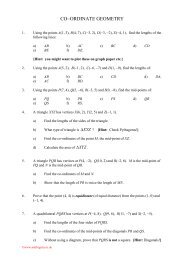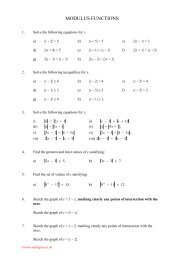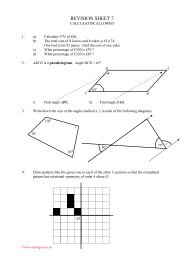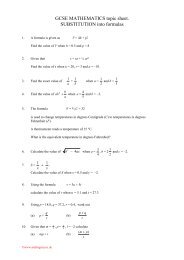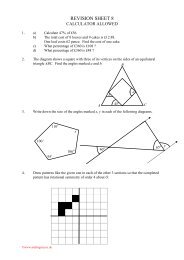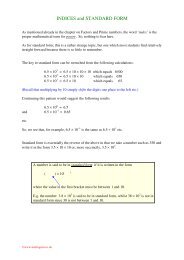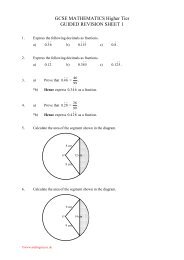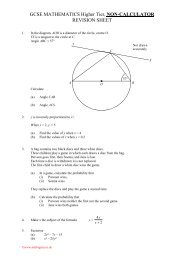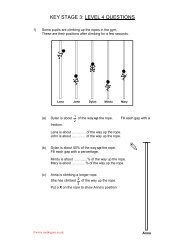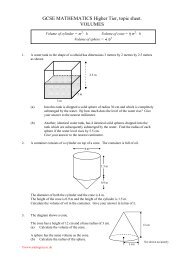GCSE MATHEMATICS Higher Tier, topic sheet. INDICES
GCSE MATHEMATICS Higher Tier, topic sheet. INDICES
GCSE MATHEMATICS Higher Tier, topic sheet. INDICES
Create successful ePaper yourself
Turn your PDF publications into a flip-book with our unique Google optimized e-Paper software.
<strong>GCSE</strong> <strong>MATHEMATICS</strong> <strong>Higher</strong> <strong>Tier</strong>, <strong>topic</strong> <strong>sheet</strong>.<br />
<strong>INDICES</strong><br />
Rule i) x m × x n = x m + n . Rule ii) x m ÷ x n = x m n .<br />
Rule iii) ( x m )<br />
= x mn . Rule iv) x 0 = 1.<br />
Rule v) x n = 1 n n<br />
n<br />
. Rule vi) x = x , the n th root of x<br />
x<br />
1<br />
1. Evaluate<br />
a) 4 2 , b)<br />
1<br />
3<br />
8 .<br />
2. Evaluate the following.<br />
a)<br />
1<br />
2<br />
25 , b) 3 2 , c) 2 3 × 2 6 , d)<br />
2<br />
3<br />
8 ,<br />
e) 1000 0 3<br />
4<br />
, f) 16 g) 1 4 .<br />
3. Simplify<br />
a) t 3 × t 5 ,<br />
b) p 6 ÷ p 2 ,<br />
c)<br />
a × a<br />
a<br />
3 2<br />
.<br />
4. a) Work out the value of 2 1 3<br />
x when x = 8.<br />
2<br />
b) Mary wanted to work out ( ) 1 3<br />
64 but she had lost her calculator.<br />
Explain how she could do this calculation mentally.<br />
5. a)<br />
3<br />
2<br />
x can be written as x × 1 2<br />
x . Use this result to factorise<br />
1<br />
2<br />
3<br />
2<br />
b) Simplify x + x .<br />
2 3<br />
x + x<br />
x<br />
1<br />
3<br />
2 2<br />
+ x .<br />
2<br />
x y<br />
6. Express in the form x a y b .<br />
2<br />
xy<br />
State clearly the values of a and b.<br />
7. Simplify<br />
ac<br />
6 4<br />
2 5<br />
ac .<br />
www.mathsguru.co.uk
8. a) Evaluate i) 3 4 , ii) 9 0 , iii)<br />
1<br />
2<br />
49 .<br />
b) Simplify<br />
4ac×<br />
3ab<br />
2<br />
6ab<br />
3 3<br />
.<br />
9. Simplify fully<br />
2ab<br />
× 6ab<br />
3<br />
4ab<br />
3 2 4 2<br />
.<br />
2<br />
10. Simplify ( 3xy ) 4<br />
.<br />
11. Simplify a) x 5 × x 2 , b) y 5 ÷ y 2 .<br />
12. a) Multiply out and simplify ( x + 6 ) 2<br />
.<br />
b) Triangle ABC has a right angle at B.<br />
B<br />
x + 6 x – 6<br />
C<br />
A<br />
2 11<br />
Find the value of x.<br />
You must explain clearly how you obtain your answer.<br />
www.mathsguru.co.uk
SOLUTIONS / ANSWERS.<br />
1. a) 4 2 1<br />
=<br />
4 = 1<br />
2<br />
16 .<br />
1<br />
b) 8 3<br />
= 3 8 = 2.<br />
1<br />
2<br />
2. a) 25 = 25 = 5, b) 3 2 1<br />
=<br />
3 = 1 2<br />
9 , c) 23 + 6 = 2 3 = 8, d)<br />
e) 1000 0 3<br />
4<br />
= 1, f) 16 1 1<br />
=<br />
3<br />
4<br />
1 3<br />
16 4<br />
16 = ( )<br />
2<br />
3<br />
8 = ( ) 2 3<br />
8 = 2 2 = 4,<br />
1<br />
=<br />
2 = 1 3<br />
8 , g) 14 = 1 × 1 × 1 × 1 = 1.<br />
3. a) t 3 × t 5 = t 3 + 5 = t 8 . OR t × t × t × t × t × t × t × t which equals t 8 .<br />
b) p 6 ÷ p 2 = p 6 2 = p 4 .<br />
c)<br />
3 2<br />
a × a<br />
=<br />
a<br />
5 1<br />
a a = a5 1 = a 4 .<br />
4. a) 2 × 1 3<br />
8 = 2 × 3 8 = 2 × 2 = 4.<br />
2<br />
b) ( ) 1 3<br />
64 =<br />
2<br />
1<br />
3<br />
64 = ( )<br />
3<br />
2<br />
64 = ( ) 2<br />
3<br />
64 = 4 2 = 16.<br />
5. a)<br />
b)<br />
x<br />
1<br />
3<br />
2 2<br />
+ x = 1 1<br />
2 2<br />
x + x × x = x<br />
1 2 (1 + x)<br />
.<br />
3<br />
1<br />
2 2<br />
x + x<br />
2 3<br />
x + x<br />
This can only be simplified by cancelling.<br />
Now a fraction represents a division and as such, ‘divisions’ will only cancel<br />
‘multiplications’. This means that we should factorise both the numerator and<br />
denominator of the fraction.<br />
x<br />
x<br />
3<br />
1<br />
2 2<br />
+ x<br />
+ x<br />
2 3<br />
=<br />
1<br />
2<br />
x (1 + x)<br />
2<br />
x (1 + x)<br />
which cancels down to give<br />
1<br />
x 2<br />
2<br />
x .<br />
Using the rules of indices, we now get that<br />
6. This requires the use of rule ii).<br />
2<br />
2<br />
1<br />
x y x y<br />
= × = x 2 1 × y 1 2 = x 3 × y 1 .<br />
2 1 2<br />
xy x y<br />
Thus a = 3 and b = 1.<br />
1<br />
x 2<br />
2<br />
x<br />
= 1 2 2<br />
x =<br />
3<br />
2<br />
x .<br />
7.<br />
ac<br />
ac<br />
6 4<br />
2 5<br />
= a 6 2 × c 4 5 = a 4 × c 1 . OR<br />
ac<br />
ac<br />
6 4<br />
2 5<br />
= a × a × a × a × a × a × c × c × c × c<br />
a× a× c× c× c× c×<br />
c<br />
4<br />
a<br />
= (after cancelling!)<br />
c<br />
www.mathsguru.co.uk
8. a) i) 3 4 1<br />
=<br />
3 4<br />
= 1 81 .<br />
ii) 9 0 = 1.<br />
b)<br />
4ac×<br />
3ab<br />
2<br />
6ab<br />
3 3<br />
=<br />
12<br />
4 3<br />
abc<br />
2<br />
6ab<br />
= 2a 2 b 2 c.<br />
9.<br />
2ab<br />
× 6ab<br />
3<br />
4ab<br />
3 2 4 2<br />
=<br />
12ab<br />
3<br />
4ab<br />
7 4<br />
= 3a 6 b.<br />
2<br />
10. ( 3xy ) 4<br />
= (3xy 2 ) × (3xy 2 ) ×(3xy 2 ) ×(3xy 2 ) = 81x 4 y 8 .<br />
11. a) x 5 × x 2 = x 5 + 2 = x 3 , b) y 5 ÷ y 2 = y 5 (2) = y 7 .<br />
12. a) ( x + 6 ) 2<br />
= ( x 6 )( x 6 )<br />
+ + = x 2 + 6 x + 6 x + 6<br />
= x 2 + 2 6 x + 6.<br />
b) Use Pythagoras: ( 2 11 ) 2<br />
= ( x + 6 ) 2<br />
+ ( x 6 ) 2<br />
4 × 11 = {x 2 + 2 6 x + 6} + {x 2 2 6 x + 6}<br />
44 = 2x 2 + 12<br />
hence 32 = 2x 2<br />
16 = x 2 .<br />
This means that x = 4. {x cannot equal 4 since the lengths of the sides<br />
must be positive.}<br />
www.mathsguru.co.uk




